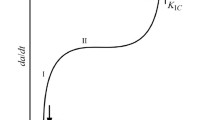Abstract
A model for the pressure-dependent diffusion and accumulation of hydrogen ahead of a decohesive intergranular crack front is developed. In the model, the pressure dependency of the diffusion is incorporated into the activation energy of an Arrhenius form of the material diffusivity along high-diffusivity grain boundaries. A key feature of the model is the ability to describe the trapping of hydrogen ahead of a decohesive crack front, which is observed in laboratory experiments.
Similar content being viewed by others
REFERENCES
Gerberich, W.W., Livne, T., Chen, X. F., Kaczorowski, M. (1988). Crack growth from hydrogen-temperature and microstructural effects in 4340 steel. Metall. Trans. 19A, 1319-1334.
Zohdi, T. 1. and Meletis, E. 1. (1992). On the intergranular hydrogen embrittlement mechanism ofAI-Li alloys. Scripta Metallurgica. 26, 1615-1620.
Doig, P. and Jones, T. (1977) A model for the initiation of hydrogen embrittlement cracking at notches in gaseous hydrogen environments. Metall. Trans. 18A, 1993-1998.
Unger, D. J. and Aifantis, D. C. (1983) On the theory of stress-assisted diffusion, II. Acta Mechanica. 47,117-151
Unger, D. J., Gerberich, W. W. and Aifantis, D. C. (1982) Further remarks on the im-plications of steady-state stress-assisted diffusion on environmental cracking. Scripta Metallurgica. 16,1059-1064
Sofronis, P. and McMeeking, R. M. (1989). Numerical analysis of hydrogen transport near a blunting crack tip. J. Mech. Phys. Solids 37, 317-350.
Lufrano, J. and Sofronis, P. (1996). Numerical analysis of the interaction of solute hydrogen atoms with the stress field of a crack. Int. J. Solids Structures 33, No. 12. 1709-1723.
Lufrano, J., Sofronis, P. and Birnbaum, H. K. (1996). Modeling of hydrogen transport and elastically accommodated hydride formation near a crack tip. J. Mech. Phys. Solids. 44,179-205.
Lufrano, J., Sofronis, P. and Birnbaum, H. K. (1998). Elastoplastically accommo-dated hydride formation and embrittlement. J. Mech. Phys. Solids. 46 No. 9, 1497-1520.
Hill, R. (1950). The mathematical theory of plasticity. Clarendon Press.
McMeeking, R. M. (1977). Finite deformation analysis of crack tip opening in elastic-plastic materials and implications for fracture. J. Mech. Phys. Solids. 25, 357-381.
Author information
Authors and Affiliations
Rights and permissions
About this article
Cite this article
Zohdi, T.I. Some Remarks on Hydrogen Trapping. International Journal of Fracture 106, 9–14 (2000). https://doi.org/10.1023/A:1022613916513
Issue Date:
DOI: https://doi.org/10.1023/A:1022613916513




